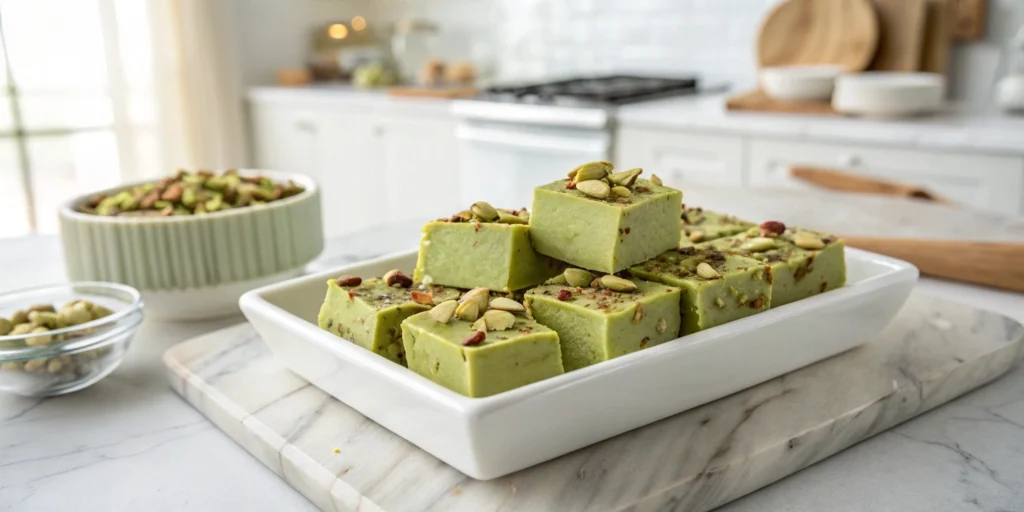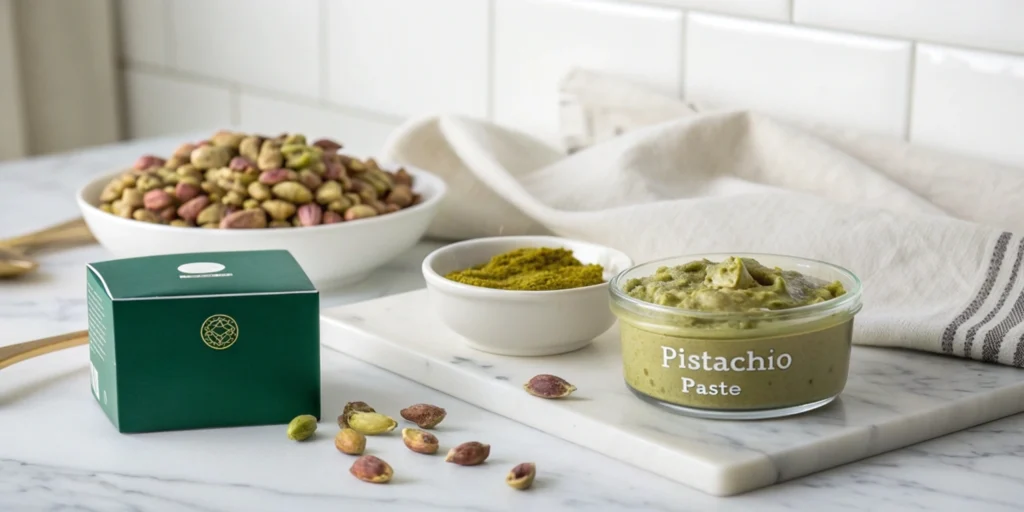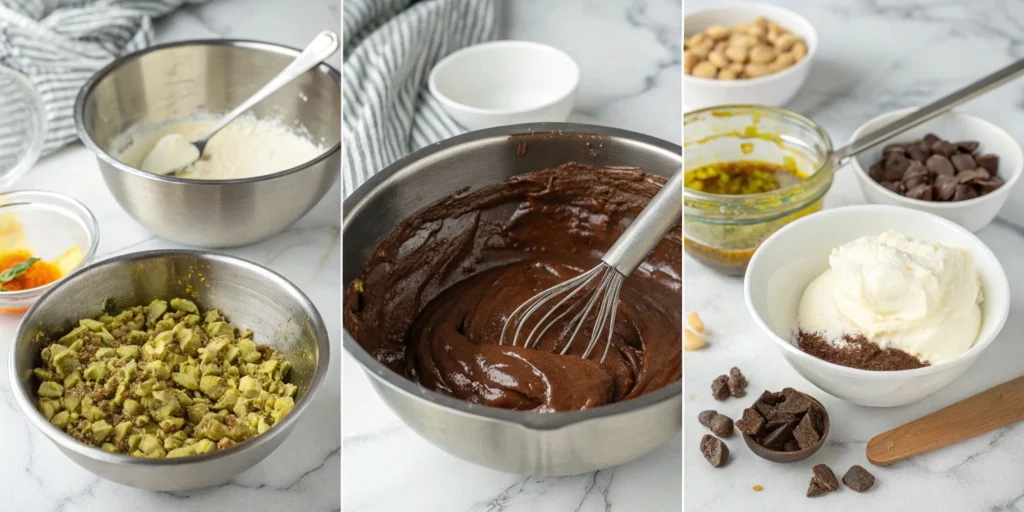
Table of Contents
You planned on having just one square. Maybe two. But somehow, half the pan of pistachio fudge disappeared. And now you’re left wondering why such a small piece of dessert made such a big dent in your energy, mood, and health goals. Sound familiar?
You’re not alone. Pistachio fudge has taken over dessert tables, Pinterest boards, and viral recipe reels. Its creamy texture, nutty crunch, and inviting green hue make it feel like the perfect treat. But beneath its melt-in-your-mouth surface, this dessert carries some hefty health baggage.
Let’s break down why this trending sweet isn’t always what it seems—and how you can make better choices without giving it up entirely.
Sugar Content in Pistachio Fudge Is Higher Than You Think
When you whip up a batch of pistachio fudge, the ingredients list may seem harmless at first glance. But once you start measuring, the numbers quickly add up. A typical batch calls for:
- Two cups of white chocolate chips
- One 14-ounce can of sweetened condensed milk
- One 3.4-ounce box of instant pistachio pudding mix
- Half a cup of chopped pistachios (optional)
This combination packs a serious sugar punch. Just the condensed milk alone brings over 160 grams of added sugar. Add that to the white chocolate chips and pudding mix, and you’re staring at a dessert that often exceeds 20 grams of sugar per small square.
Your daily sugar limit, according to the American Heart Association, should stay under 25 grams for women and 36 grams for men. That means one indulgent serving could max out your day’s worth of sugar in a single bite.
Why It Matters for You
- Sharp blood sugar spikes can lead to quick crashes
- Excess sugar increases inflammation and belly fat storage
- Long-term overconsumption can contribute to insulin resistance
- Hidden sugars can derail clean eating routines
You don’t need to swear off pistachio fudge forever. But if you’re aiming to keep your energy steady and reduce your risk of chronic issues, this dessert may need a few smart swaps.
Most Pistachio Fudge Doesn’t Contain Real Pistachios
You’d expect pistachio fudge to showcase its namesake nut. But in many popular recipes, the bulk of the flavor comes from artificial pistachio pudding mix—not actual pistachios.
That little green packet brings more than just flavor. It typically contains:
- Artificial pistachio and almond flavorings
- Hydrogenated oils
- FD&C Yellow 5 and Blue 1 dyes

Those colorants aren’t just there for looks. They can cause sensitivities in children and trigger reactions in people with dye intolerances. And if you’re trying to avoid processed foods, this mix pushes you in the opposite direction.
What You Can Do Instead
If you’re going to treat yourself, at least make it real. You can build a more authentic version of pistachio fudge using:
- Half a cup of roasted pistachios, finely ground into a paste
- One teaspoon of almond extract (to deepen the nutty profile)
- One to two tablespoons of maple syrup or date syrup to lightly sweeten
- Matcha powder or a dash of spirulina for natural color
This version may take a little extra time, but the result tastes richer, looks just as appealing, and gives your body something better to work with.
The Fat You Didn’t Know You Were Eating
White chocolate doesn’t just sweeten pistachio fudge. It also packs in a heavy dose of saturated fat—the kind that raises your LDL cholesterol and contributes to plaque buildup in arteries. When paired with full-fat condensed milk, each square of fudge turns into a calorie-dense block of saturated fat.
Depending on your portion size, you could be consuming:
- 8 to 12 grams of saturated fat per piece
- Up to 250 calories in one small serving
That adds up fast if you’re grabbing more than one square—and let’s be honest, you probably are.
Why It Impacts Your Health
- High saturated fat intake increases heart disease risk
- It also affects metabolic health and hormone regulation
- Makes weight management harder over time
You can still enjoy richness without overwhelming your arteries. All it takes is a few tweaks to how you build the base.
A Better-For-You Pistachio Fudge Recipe
Want to satisfy your pistachio fudge craving without the sugar spikes, artificial dyes, and excess fat? Here’s a lighter version you can make at home that still delivers the creamy texture and nutty flavor you love.

What You’ll Need:
- One and a half cups of dark chocolate chips (at least 70% cocoa)
- Half a cup of unsweetened coconut cream
- Half a cup of pistachio paste (made from roasted pistachios)
- One teaspoon of almond extract
- Two tablespoons of maple syrup (optional, for extra sweetness)
- One-fourth cup of chopped pistachios for topping
How to Make It:
- Gently melt the dark chocolate and coconut cream together in a heat-safe bowl over simmering water.
- Stir in the pistachio paste, almond extract, and maple syrup until fully combined.
- Pour the mixture into a parchment-lined square dish.
- Sprinkle chopped pistachios on top.
- Refrigerate for at least two hours or until set.
- Slice into squares and store in an airtight container in the fridge.
You’ll still get that indulgent, melt-in-your-mouth texture, but with far less sugar and no artificial extras. Plus, the pistachios provide fiber, protein, and heart-healthy fats—a win all around.
Frequently Asked Questions About Pistachio Fudge
Is pistachio fudge bad for you?
Not inherently, but traditional recipes can be high in sugar, fat, and artificial ingredients. Making small changes helps you enjoy it more mindfully.
Can I make pistachio fudge without pudding mix?
Yes! You can use pistachio paste or finely ground roasted pistachios combined with almond extract for a more natural flavor.
Is there a vegan version of pistachio fudge?
Absolutely. Use dairy-free dark chocolate and replace condensed milk with coconut cream or cashew cream for a plant-based version.
How long does pistachio fudge stay fresh?
When stored in an airtight container in the refrigerator, pistachio fudge lasts up to two weeks.
The Takeaway: Balance Matters
You don’t need to give up pistachio fudge to maintain a healthy lifestyle. You just need to pay closer attention to what goes into your version of it. When you skip the shortcuts and choose whole ingredients, you’re treating your body to something better—without sacrificing flavor.
So next time the craving hits, reach for your whisk, grab those roasted pistachios, and take control of your sweet treat. Your taste buds will thank you. And so will your heart.
Hungry for more smart dessert swaps? Leave a comment below or share your go-to healthier fudge combo—you just might inspire someone else’s next batch.
